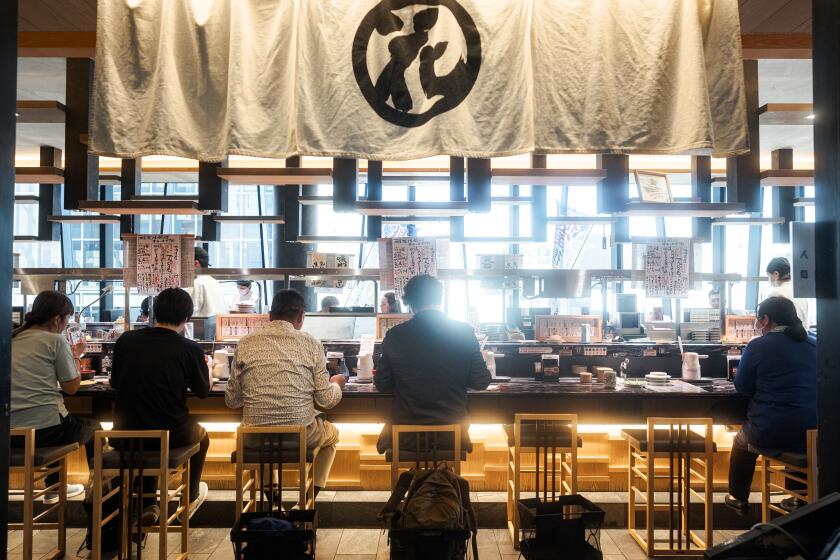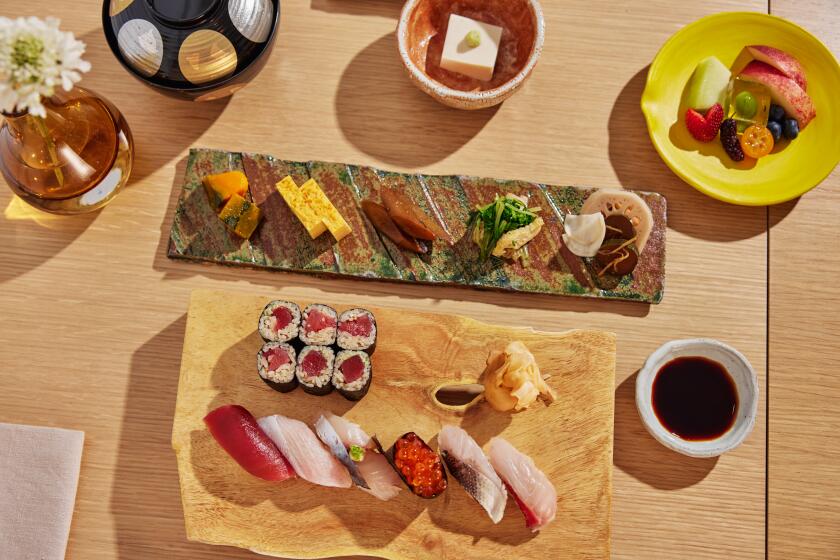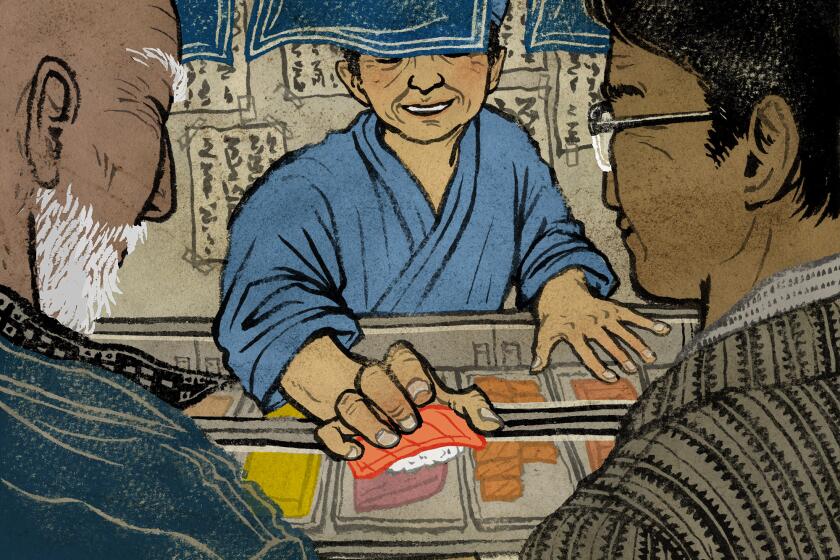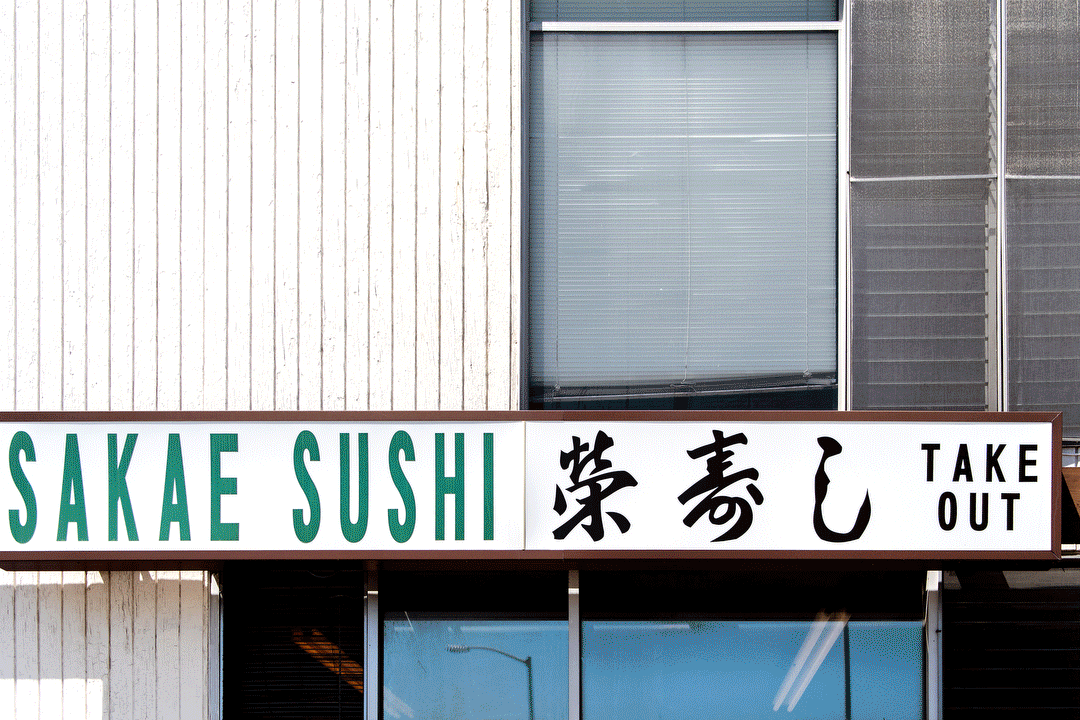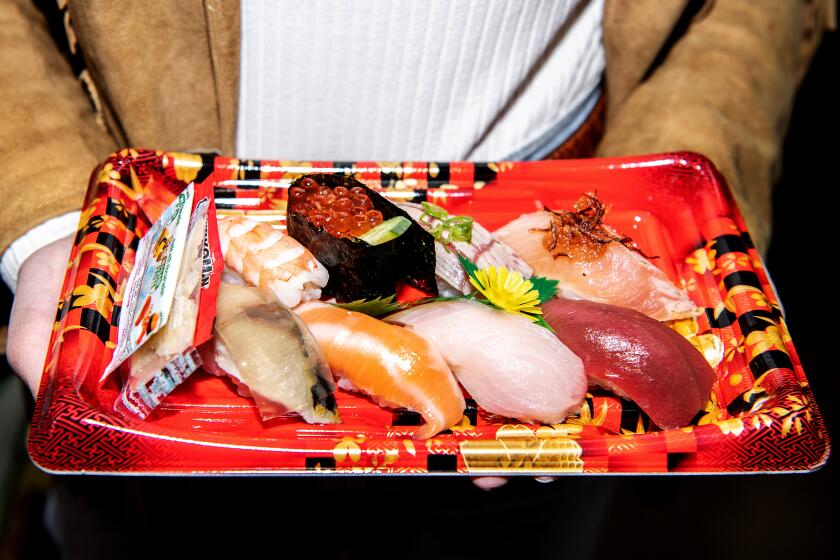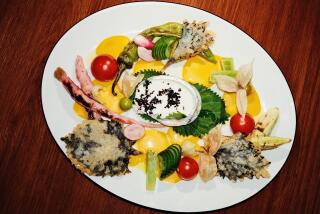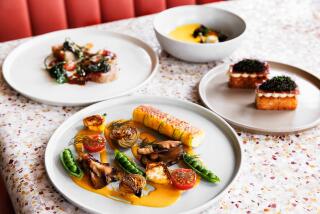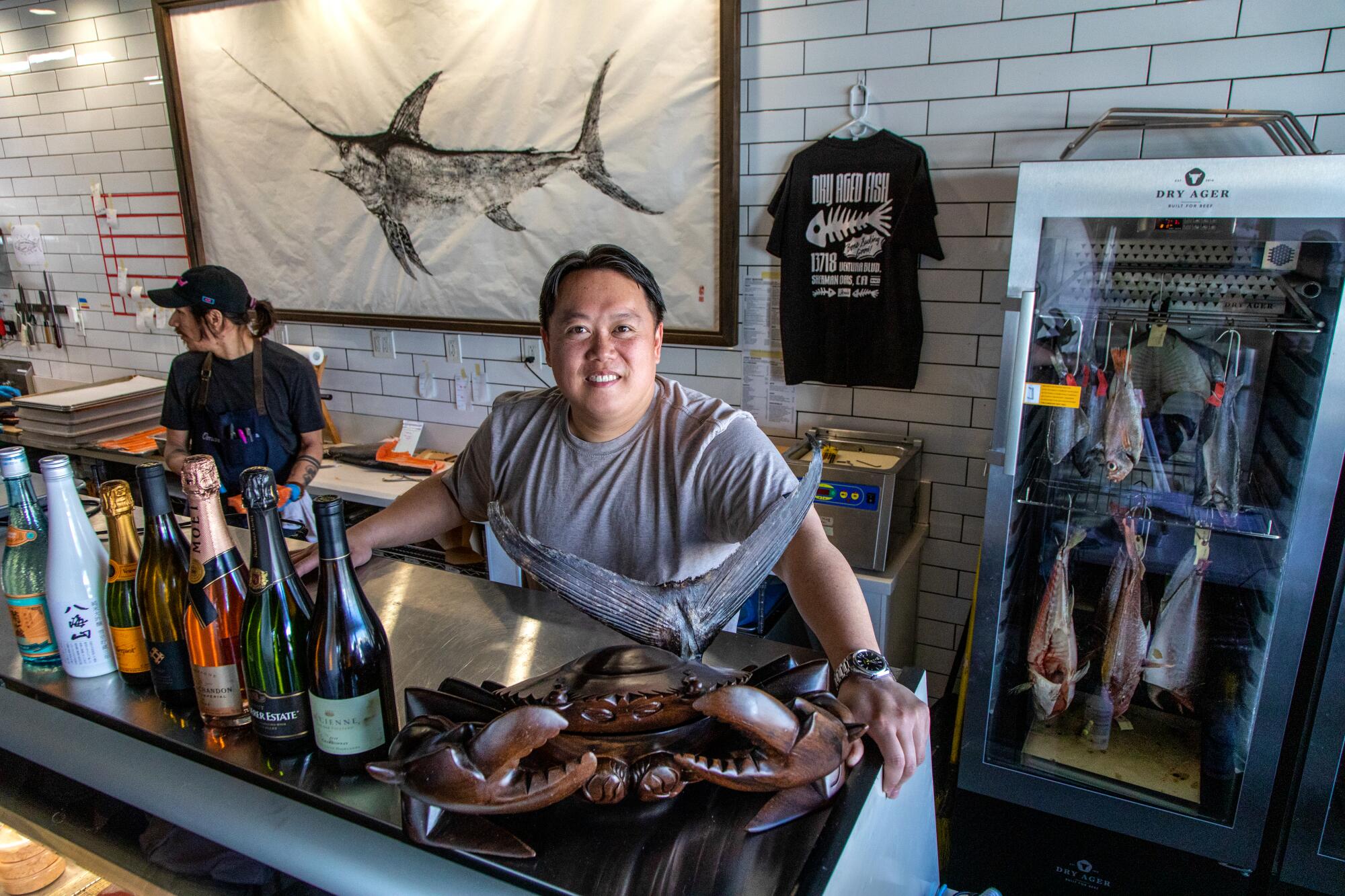
- Share via
Liwei Liao, owner of the Joint fish market in Sherman Oaks, has a motto: “Fresh is boring.” Coral-red snappers from Japan hang upside down in the rows of refrigerators, mouths agape and eyes bright and glassy, as if they‘ve just been plucked from the water — but they’ve been dead for weeks. That’s the surprising thing about the dry-aged fish here — just how pristine it is. Liao has managed to almost bend the march of time with a meticulous process, and chefs and home cooks are eating it up.

Liao’s dry-aged seafood crops up on menus across L.A., landing atop white tablecloths and in alleyway pop-ups alike: in a version of Hainan chicken rice at Yang’s Kitchen in Alhambra, hearth-roasted branzino at Etta in Culver City, 18-day toro nigiri at Sushi Note in Sherman Oaks, pescado a la brasa at Damian downtown and turbot meunière at Bell’s in Los Alamos.
And a sprawling new facility in Vernon with the capacity to dry-age 25,000 pounds of seafood a week is set to bring a taste to more dining rooms soon.
This is your guide to what the best sushi city in America has to offer, from the ultimate California roll to spectacular omakase.
Liao’s product is trendy, but that doesn’t mean it’s a flash in the pan. “A lot of people say, ‘Oh, it’s just a trend.’ They see it on social media. For us, we don’t do it because it’s a trend,” the fishmonger says. “We do it because it actually delivers a better product.”
Dry-aging is far from new, he acknowledges, but nearly all of the centuries-old methods involve some form of preservative, be it smoke, salt or nitrates. His methods, Liao says, yield results unlike many of the conventions that came before: There is no smokiness, no overt saltiness, simply a more pronounced taste of the muscle of the fish and a slightly more condensed, buttery consistency.
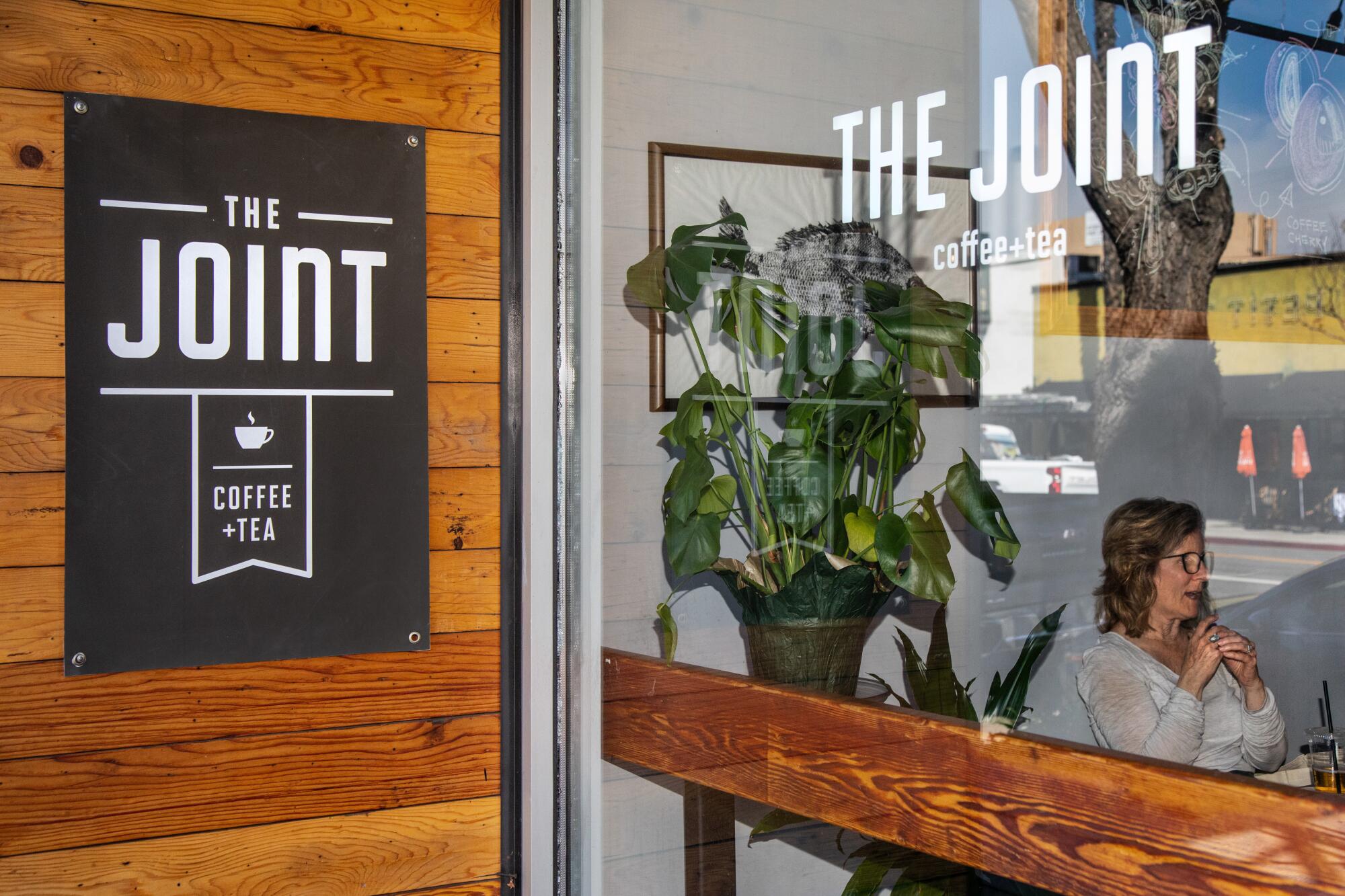
“Most people that eat my fish say, ‘Oh, wow, that tastes fresh,’” Liao says, “because in their mind it still represents what fresh should be: It’s very crisp, it’s very clean, it has a lot of clarity, it has a lot of texture.”
At the Joint, roughly a dozen dry-aging fridges display the wares: tuna from Spain, barramundi from Arizona, salmon from New Zealand, black cod from British Columbia, hamachi from Japan. The rows of fish are mesmerizing, their eyes staring back from behind the glass doors, with the fridges programmed to various settings. Some are set to purge more moisture within 48 hours, others are tailored to fish that have been aging for one to two weeks already and have achieved a kind of stasis. Some fish retain their heads, some have been lopped off. Liao prefers to keep his fish as intact as possible when aging because every aspect — the eyes, the gills, the fins — serves as an indicator for the fish’s freshness and progress as it ages.
The current generation of omakase chefs in Los Angeles are returning to the essence of the cuisine. A trip to Tokyo confirms what’s been driving their pursuit for excellence.
The Joint processes and dry-ages 3,000 to 4,000 pounds each week; its new processing facility, slated to open in Vernon later this year or early next, will feature what Liao calls “the biggest dry-aging chamber for fish in the world” and will more than quintuple capacity. The height from the floor of the Joint to the ceiling is 15 feet; the chambers in the new facility stand 22 feet tall. In Sherman Oaks, Liao and his team can process 25 or 30 different species, but the larger facility will allow for increased volumes of their most popular fish — branzino, salmon and sea bream — for restaurant groups and hotel chains.

How, exactly, does Liao’s dry-aging work? The answer varies depending on the size and species of fish, but for some, it takes weeks before the proteins begin to break down while the blood, water and “slime” evaporate.
“With branzino to tuna,” Liao says, “it’s like you’re comparing quail to beef.” A 600-pound tuna could age for 18 to 21 days, whereas a 1-pound branzino needs only three or four.
From 20-course omakase tasting menus to snug sushi bars, here’s where to find the best and freshest sushi in Los Angeles.
The precision of his dry-aging refrigerators — each with roughly 50 parameters that control the environment — is what make his methods possible. Around 2016, he began tinkering with fridges built for dry-aging beef, customizing sensors and modifying the compressors, evaporators, defrost cycles and fans to extract moisture from the seafood, avoiding both frost and rot.
Don’t try this at home. Humidity control, consistent temperature and stability can’t be achieved with a standard home fridge or at least not at this level; attempts to dry-age your salmon for two weeks at home most likely will lead to decay and an extremely unpleasant scent. Best to leave it to the pros, especially one who’s been experimenting for decades.
A family hobby spurred his love of the trade. Liao moved to New York at age 4 or 5; in Taiwan, his father was what Liao calls “a true outdoorsman,” and that continued in the States.
Liao grew up in the Bayside neighborhood of Queens, N.Y., fishing from his family’s boat. Sometimes the Liaos would catch far more fish than they could consume and would store it in refrigerators or coolers for as long as they could without placing it in “the black hole” of their freezer.
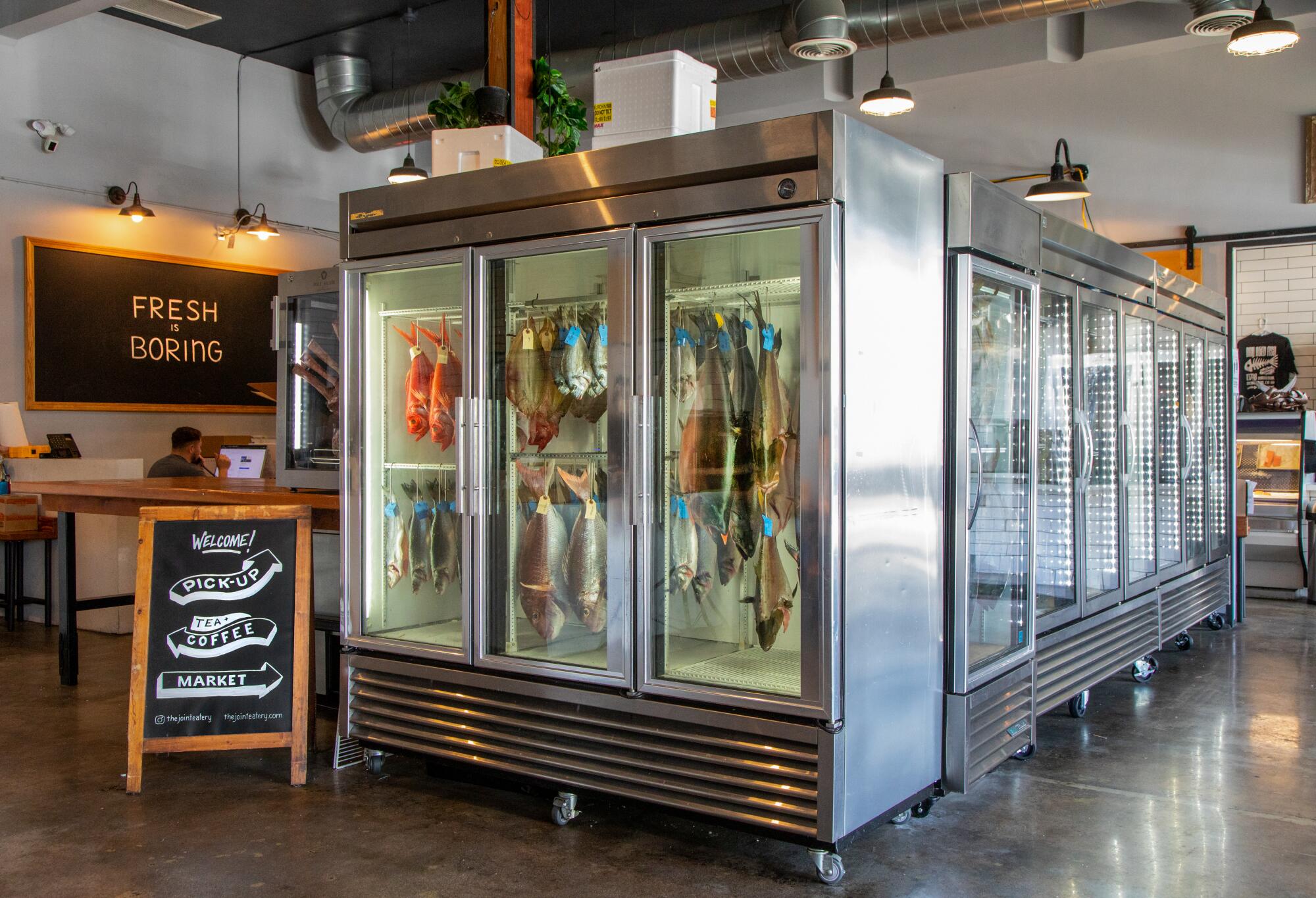
“Being Asian, nothing went to waste,” Liao says. “We had to keep it for as long as possible. Over the last 30 years, through that experience, I created my own methods of how to maintain and condition fish from the moment it leaves the water.”
Sushi’s norm-busting journey from culinary curiosity to mainstream L.A. offering was set in motion in the 1960s by two friends bound by a love for food.
Fish in large coolers packed with gas-station ice would begin to bruise after a few days; this inspired Liao and his father to stand the coolers up against a tree as vertically as possible, placing the fish’s weight on its nose. Today, the Joint’s fish hang from hooks pierced through their tails: Hanging the seafood head-side down, Liao says, allows for impurities to exit the fish, as opposed to being stored in the tail.
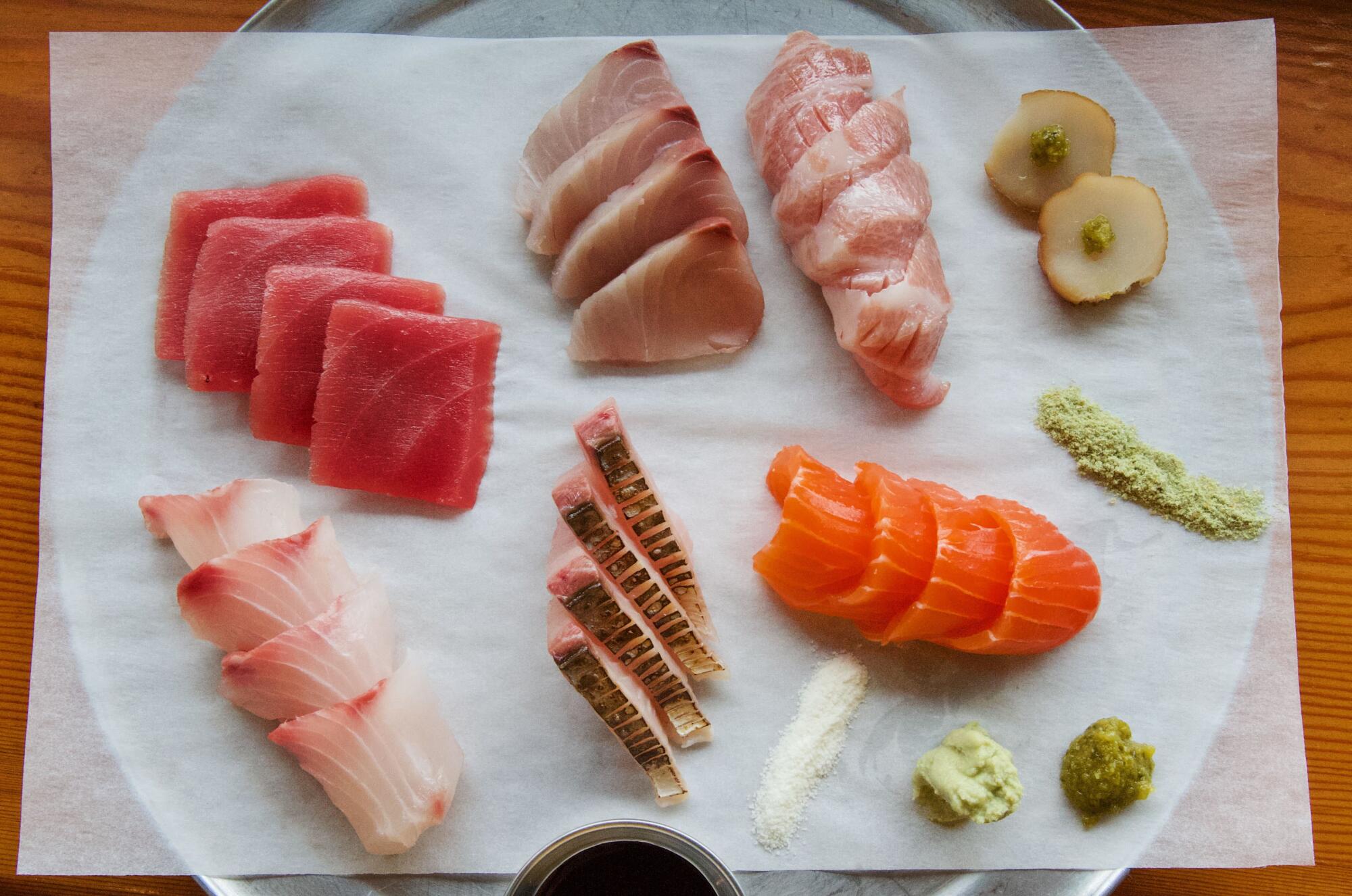
Liao moved to L.A. in 2000 to study civil and mechanical engineering and dabbled in various fields, including food service with a boba truck he helped design and build. A stint as a global supply chain manager helped shape his understanding of how products traverse the world; this would come in handy when he began sourcing seafood. But it wasn’t until a visit to a chain supermarket — where he was appalled by the quality of the fish — that he decided to open the Joint. To some, it was inevitable. “It was always a running family joke that I catch so much fish I should sell it,” he says.
Liao opened the Joint in 2018 with his brother, David, and modeled it after every other seafood market: fresh fish laid out on ice whole and in large filets, rapidly deteriorating and, when not sold within a day or two, causing waste. It was, he says, unsustainable. Liao began hanging fish in the back of the shop, hidden from view over concerns that the fish eyes staring back at customers might scare them away from a sale.
Sakae Sushi has been making simple, homestyle sushi in Gardena since the 1960s. Every piece on the six-item menu is inexpensive and delicious.
But his dry-aged fish began to take off, becoming so popular that the amount of hanging fish could no longer be hidden in the back. He started with one small display out front, which got customers asking questions, which spurred more orders. Over the course of the COVID-19 pandemic, four, five, six, seven fridges sprung up, encroaching into the cafe seating area. But the storefront was a stepping stone to Liao’s biggest goal: to become a wholesaler, increasing his order sizes and in turn creating better connections for sourcing fish from around the globe.
Liao began developing relationships with chefs, expanding his roster of wholesale customers into one of the most impressive in the city: Damian, Merois, Rustic Canyon, n/naka, Etta, Cobi’s, Manuela, Verse, Workshop, Hatchet Hall, Niku X, Sushi Note. And he provides guidance for chefs who’ve begun dry-aging on their own premises, such as Providence’s Michael Cimarusti and the Brothers Sushi’s Mark Okuda. Liao stocks restaurants beyond L.A. too, shipping his fish to chef Dominique Crenn in San Francisco, Catbird Seat in Nashville, Jônt in Washington, D.C., and multiple restaurants in Florida.
Intrigued by dry-aged fish for nearly a decade, sushi chef Okuda long hoped to experiment with such techniques but admits he was too fearful of botching it to try — until he met Liao. Now, he says dry-aged fish makes up roughly half the menu at his Woodland Hills and Santa Monica sushi restaurants, including nearly all of the sashimi. It wasn’t until 2020, when Okuda closed indoor dining due to the pandemic and found himself with extra time to experiment, that he began purchasing from Liao for Brothers’ new to-go menu. He loved the results so much that he installed dry-aging fridges in both restaurants under the guidance of Liao, who sells him fresh fish to age on-site.

Though dry-aging has become a large focus at Brothers since 2020, it can still take a moment for customers to understand.
“When I say ‘dry-aged,’ I think two things pop into their minds: ‘Is it like a fish jerky, is it too dry?’ Or, ‘Is it like beef?’” he says. They want to know if it’s hard or chewy. Usually, he tells them that it’s similar to the process used in dry-aged beef; they’re almost always shocked, he says, to taste something tender, and regularly ask if he’s certain the fish is weeks old.
Daniel Son began dry-aging as early as 2015, learning to repeatedly draw out moisture from fish using Pichitto drying sheets when he worked under Seiji Yamamoto in Tokyo at lauded fine-dining restaurant Nihonryori RyuGin. He continued the practice when he returned to the States, even when customers and fellow U.S. sushi chefs didn’t regard the practice as “fresh” or “real sushi.” Liao, he says, helped correct that misconception.
“Now, we have these [refrigerator] dry-agers, and it’s a lot more controlled,” Son said. “It was so great seeing Liwei taking it and popularizing it.”
Liao inspired Son to purchase his own dry-aging refrigerator, and Son says it’s helping him to see how far he can push the boundaries of dry-aging. He plans to incorporate the technique in his forthcoming omakase restaurant, Sushi Sonagi in Gardena, where he expects multiple courses will involve dry-aged fish, crab and even bottarga.
That connection and discussion with chefs is crucial to Liao. He both encourages others to try dry-aging and likes to work closely with clients, determining not only when they plan to place his fish on their menus but also how: Whether it’s grilled, raw, smoked, roasted or poached will determine how long he should age it. Are they looking for fruit notes? Funk? Umami? The allure for chefs is understandable. It can also be economical: Unsold fish in the restaurant can linger for an additional few days, whereas fresh fish would need to be repurposed or discarded with both money and product lost.
Where to find the best supermarket sushi in Los Angeles — seared salmon nigiri, the freshest sashimi platters, hand rolls filled with negitoro and more.
Liao tries to practice sustainability in his storefronts. At Uoichiba, his new hand-roll bar at Citizen Public Market, tuna scraped from the tail or behind the head gets transported from the Joint to the Culver City food hall and wrapped in nori with rice. A fumet, simmered from dry-aged fish bones and heads, also is available at the temaki bar, paper cups of soup clouded with miso and bright with clean, unadulterated fish flavor. In the Joint, leftover whitefish meat is smoked and extracted, then turned into salad for the front case, while his cafe’s tuna melt uses meat that’s cooked in butter and heaped onto pressed sourdough with Gruyère. His team even makes dog food with discards.
Sitting at the center of his rapidly growing enterprise, hundreds of hanging eyes staring back at him, Liao says that he’s just getting started and that every day, his Vernon facility is closer to completion. He has big plans, and while it might take a bit more time for them all to come to fruition, the wait — as with his meticulously aged fish — most likely will be worth it.
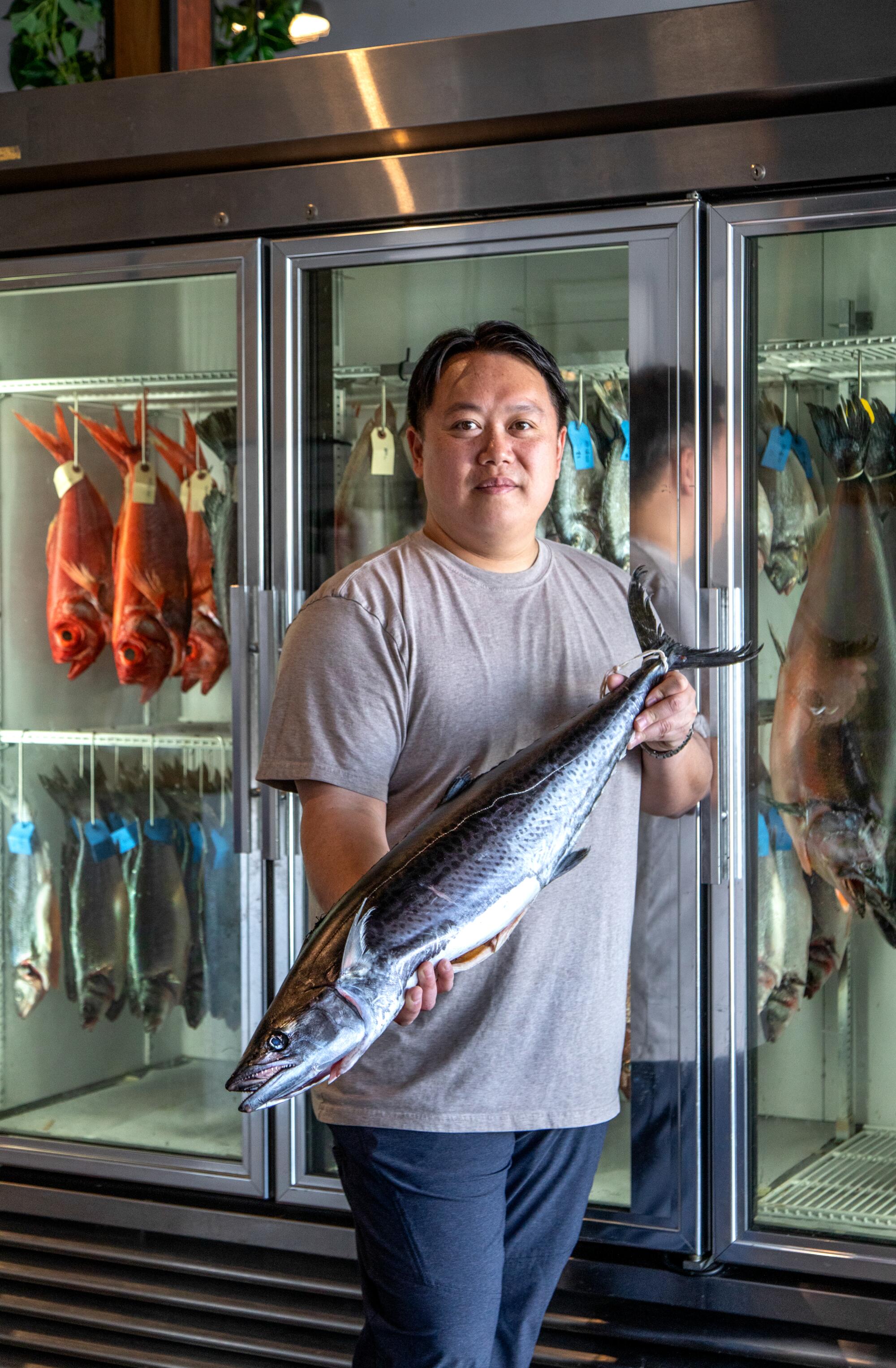
More to Read
Eat your way across L.A.
Get our weekly Tasting Notes newsletter for reviews, news and more.
You may occasionally receive promotional content from the Los Angeles Times.


